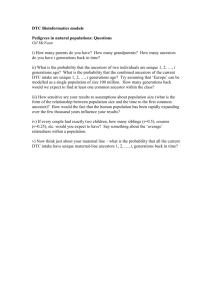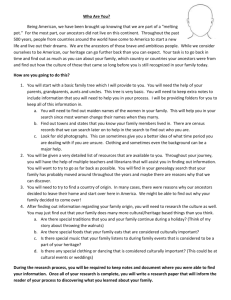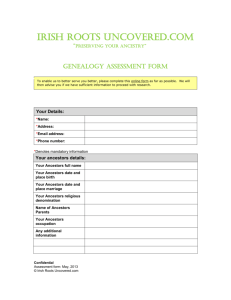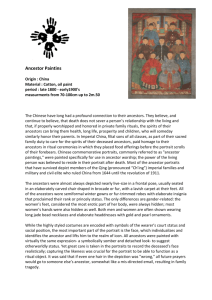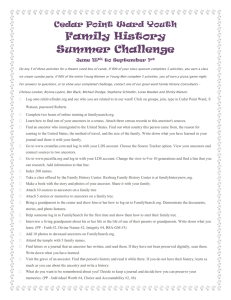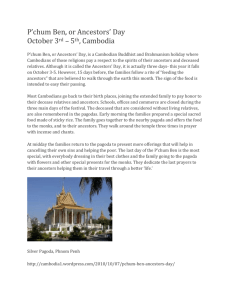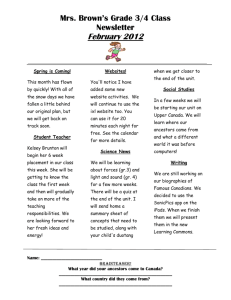Who are your cousins
advertisement
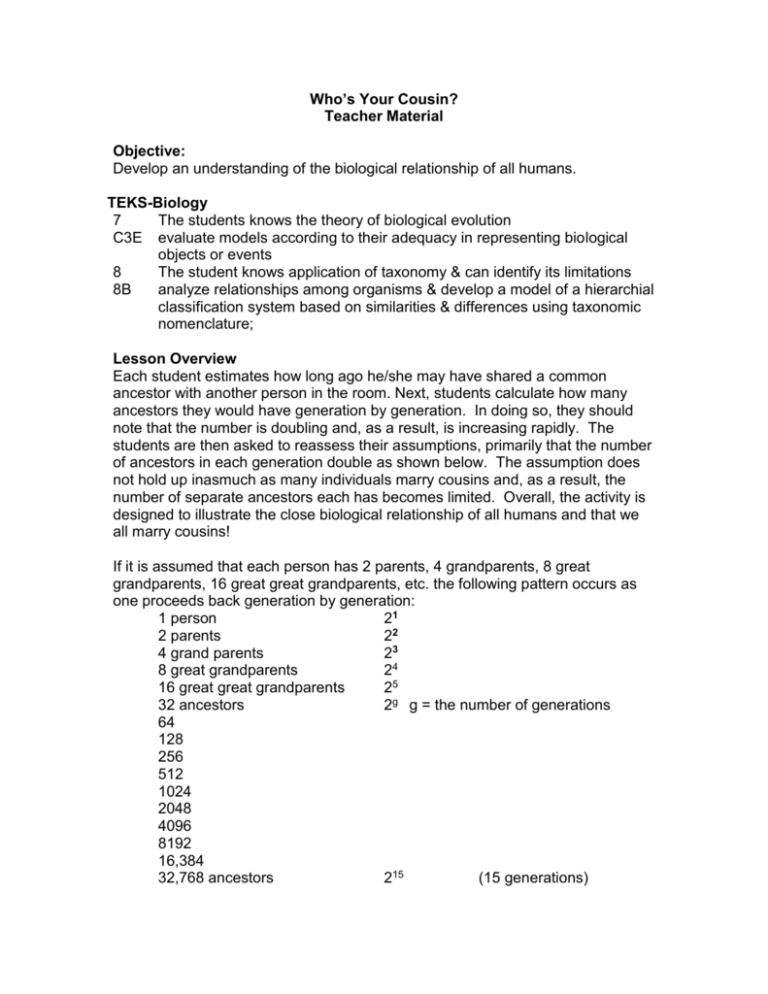
Who’s Your Cousin? Teacher Material Objective: Develop an understanding of the biological relationship of all humans. TEKS-Biology 7 The students knows the theory of biological evolution C3E evaluate models according to their adequacy in representing biological objects or events 8 The student knows application of taxonomy & can identify its limitations 8B analyze relationships among organisms & develop a model of a hierarchial classification system based on similarities & differences using taxonomic nomenclature; Lesson Overview Each student estimates how long ago he/she may have shared a common ancestor with another person in the room. Next, students calculate how many ancestors they would have generation by generation. In doing so, they should note that the number is doubling and, as a result, is increasing rapidly. The students are then asked to reassess their assumptions, primarily that the number of ancestors in each generation double as shown below. The assumption does not hold up inasmuch as many individuals marry cousins and, as a result, the number of separate ancestors each has becomes limited. Overall, the activity is designed to illustrate the close biological relationship of all humans and that we all marry cousins! If it is assumed that each person has 2 parents, 4 grandparents, 8 great grandparents, 16 great great grandparents, etc. the following pattern occurs as one proceeds back generation by generation: 1 person 21 2 parents 22 4 grand parents 23 8 great grandparents 24 16 great great grandparents 25 32 ancestors 2g g = the number of generations 64 128 256 512 1024 2048 4096 8192 16,384 32,768 ancestors 215 (15 generations) 100,000,000,000,000,000,000,000 280 (80 generations) Assuming 4 generations per century, Dawkins estimates that the common ancestor of two individuals in a classroom would have lived around the time of William the Conqueror who invaded Norman (England) in 1066. Reference: Dawkins, R. (1995). River out of Eden: A Darwinian View of Life. Basic Books: New York . (p. 33-37) Part 2 View PBS video Did Humans Evolve http://www.pbs.org/wgbh/evolution/educators/teachstuds/svideos.html (5 minutes 34 seconds) Overview: Fossil and molecular evidence support the evolution of humans from earlier primate ancestors. This video demonstrates some of the evidence for that relationship. Discussion questions: 1. What are the occasional mistakes in copying of DNA called and why are they significant for evolutionary change? 2. How does DNA evidence support the close evolutionary relationship between chimps and humans? 3. What is the difference between relatedness and descendancy? 4. What is the relationship between common ancestry and degree of DNA similarity? 5. What kinds of evidence support the fact that humans have evolved? Reference: Evolution: Teacher’s Guide. Boston: WGBH Educational Foundation. 2001 Extension Video clips showing cognition in rhesus monkeys can be viewed at: http://www.mind.duke.edu/level2/faculty/liz/pcl.htm (monkey quizcounting) http://www.columbia.edu/cu/psychology/primatecognitionlab/index.html (sequencing illustrations) Student Material Who are your cousins? 1. How far back in time do you think an individual lived who is your ancestor as well as that of another person in this room? As a result of sharing a common ancestor, the two of you would be cousins! 2. Calculate how many ancestors you would have after 15 generations? (1 person has 2 biological parents, 4 biological grandparents, 8 biological great-grand parents...) 3. What is the pattern of increase in the number of ancestors from generation to generation? 4. Develop a graph that shows the growth in numbers of your ancestors during 15 generations? What is the pattern of increase shown in the graph? 5. The number of ancestors present in a generation equals 2g (g represents the generation number) as follows: 1st generation has 21 ancestors (parents) 2nd generation has 22 or 4 grandparents 3rd generation has 23 ancestors, or 8 grandparents 80th generation has 280 or 100,000,000,000,000,000,000,000 ancestors present. Do you want to change your estimate of how long ago someone lived who is an ancestor of both you and another person in this room? Explain 6. Are there any errors in the assumptions used to arrive at the number of your ancestors in each generation? Explain.
